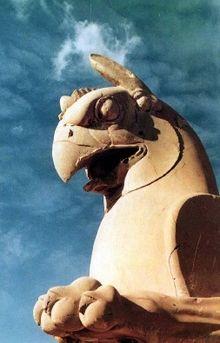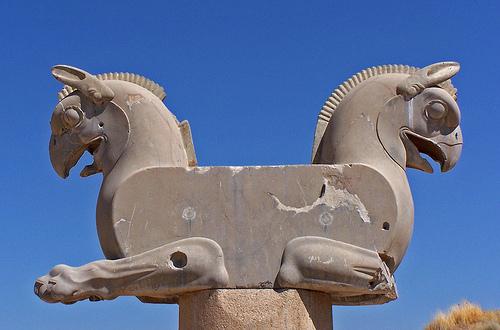Introduction
The ancient city of Persepolis, the throne of Jasmid, was founded in 518 BC by Darius. It was the capital of the Persian Empire. To come up with an immense artificial and natural at the same time, the king created an impressive palace complex quite impressive as inspired by the Mesopotamians. The quality and importance of Persepolis ruin made the Persepolis recognized as the world heritage site by UNESCO (Schimmel, Attwood and Waghmar 56).
Main body
Although it had an impressive palace, Persepolis was not a convenient place for the royals. This is mainly because it was built in a mountainous region that was remote. Alexander the great later raided the city and demolished the palace of Xerxes to symbolize the end of the PanHellenic revenge war. To date, the preserved ruins of the Persepolis ruins represent its ancient glory (Curtis and Tallis 35).
The site of Persepolis location is distinguished by huge columns these are constructed of dark grey stones, which were polished with marble collected from the mountains. The construction of big stones, which were cut with precision and laid with mortar is still intact. Two columns still stand at the entrance of the Xerxes (Hunt 54).
The ruins have also indicated the ancient use of advanced mathematics, geometry, and astronomy in their construction. The art of the ancient days was well decorated with sculptures of both real and imaginary creatures. Homa bird was one of these mythical and imaginary creatures.
Huma is the name of a mythical bird that the Homa capital columns are named after, a branch in the Persian branch of Iran mythology. The legendary bird is said to have spent its entire life flying and never came to contact with the earth’s surface (Schimmel, Attwood and Waghmar 30). The bird is believed to have spent its life invisibly flying far in the sky above the earth’s surface. It never alighted on the earth’s surface, the bird is also claimed not to have had any legs according to some legends. Persepolis or the Old Persian used to be the ceremonial capital city of the Achaemenid Empire between 550 and 330 BCE.
The Huma bird is known to ingest itself in fire flames and rises afresh and new after a number of hundred years therefore, the bird can be referred to as phoenix-like. The bird is also said to be a hermaphrodite meaning, one bird contains both female and male features. Each male or female feature has one leg and one wing.


The Huma bird is considered to be a bird of fortune, with its touch being propitious. Being an empathetic bird, it is believed that when its shadow rests on a person’s shoulder, it was said to forecast power and authority. According to the Sufi teachers, the bestowed kingship legend had some spiritual dimension; this is because when a man’s thought progressed to break every limitation, he has the same characteristics as the king. Catching this bird was thought to be beyond any human imagination by the Sufi tradition. However, catching its shadow was a sure way of making one happy for the rest of their life. It was forbidden to catch the Huma bird alive; and if someone killed the bird or attempted to, he or she would die. Huma is also evident in Turkic mythology and in Tengriism, Umay as well where it represents the goddess of fertility.
The renowned bird has also been a theme in Ottoman Turkish, Urdu, as well as in Persian tradition, especially in poetry. It has appeared in a number of allegorical masterpieces, an example is Farid ud Din Attar’s conference of birds. This is a distinguishable sample of the Sufi works in Persian literature. In this masterpiece, the bird was portrayed as a pupil. In this masterpiece, the bird refused to take part in a journey for the reason that such an exercise would compromise the treats of conferring the kingship on those whom it flew over. In Iranian literature, the Huma bird is associated with monarchs who existed in the pre-Islamic period, and also in Arab’s metaphors, vis-à-vis raven, which appears in Sufi art as well (Curtis and Tallis 55).
In Turkish literature, the Homa bird is regarded as a legendary bird, mainly in Diwan poetry. The bird is also known to have avoided killing as a source of its food. Instead, the bird preferred to feed on carrion, although it has been confused with other scavenger birds like the vultures due to its feeding habits.
Homa is also featured in Sindhi literature. The bird is known to cause fortunes, just like it is the case with the Turkish Diwan tradition. The bird is also referred to as the bird that represented all other birds. This was in the short story The Aleph, as written by an Argentine writer, Borges (Parvaneh 45).
The bird has been used to symbolize the greatness of the Persepolis capital. According to the Persepolis column capital as it is in griffins form, Huma bird’s acronyms the Iranian national Airline, and also it is the emblem of the airline. The Homa bird is also used as a style that represents the Persepolis capital (Curtis and Tallis 77).
Works Cited
Curtis, John and Nigel Tallis. Forgotten Empire, the World of Ancient Persia. London: Adventure Works Press, 2005. Print.
Hunt, Patrick. “Achaemenid Persian Griffin Capital at Persepolis.” 2008. Archaeology.
Parvaneh, Pourshariati. Local Historiography in Early Medieval Iran and the Tārīkh-i Bayhaq. London: Oxford University Press, 2000. Print.
Schimmel, Annemarie, Corinne Attwood and Burzine Waghmar. The Empire of the Great Mughals: History, Art and Culture. London: Reaktion, 2004. Print.